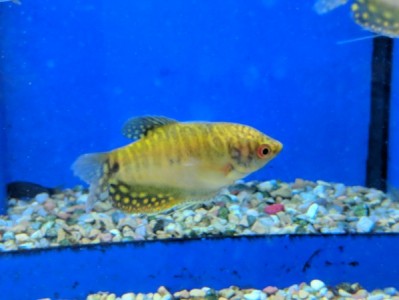- Name:
Gold Gourami
- Family: Belontiidae
- Species: Gouramis
- Scientific Name: Trichogaster trichopterus


General info about Gold Gourami
In the wild these fish are brown with yellow gill covers and have irregular black bars on the top of their bodies, they can reach 6 inches however in aquariums they never grow that much. Their name, Three Spot Gourami, comes from the two spots on their side and the third spot is the eye. The Gold Gourami was developed in captivity and doesn’t exist in the wild, it is gold, has stripes on its back and even though it was developed from the Three Spot Gourami, the Gold Gourami doesn’t have any spots on its body. These fish are able to breathe atmospheric oxygen, this ability serves as survival mechanism in areas affected by drought or heavily polluted water bodies, due to their ability of breathing atmospheric oxygen they sometimes go to the surface for a gulp of air. Gouramis are known for eating hydra which is a pest that has tentacles and venom that can paralyze small fish which are then eaten by the hydra.
To keep these fish in captivity water pH should be between 6.0 and 8.8 and water temperature should range from 73.0ºF to 82ºF. The tank should have dense vegetation, hiding places and a dark substrate. Blue Gouramis can be kept in a community aquarium with tankmates of similar size, however, different individuals have different personalities so while some are quite peaceful others are extremely aggressive and may attack their tankmates. Fin-nippers, small fish and fry should be avoided as tankmates. If kept in groups there should be 3 females per male.
Gold Gourami Diet & Nutrition
This species is omnivorous. In the wild it feeds on crustaceans, insects and zooplankton. In an aquarium they can be fed flakes complemented with live or frozen foods like bloodworms and brine shrimp, they should also be fed vegetable matter like blanched lettuce or spinach.
Determining Sex of Gold Gourami
Males have pointed fins and are larger than females.
Breeding & Spawning Gold Gourami
To breed this species in captivity, the breeding tank should have many plants and water temperature of 80ºF. A 10 to 20 gallon tank is enough. After the tank is set up, a pair of adults should be introduced to the tank. The male will start by building a bubble nest in the corner then he will swim around spreading his fins until the female lets him wrap his body around hers. The eggs will be deposited in the nest and the male will guard them, he may even attack and kill the female so she should be removed from the aquarium after the eggs are produced. Once the eggs hatch, the fry soon become free swimming, at this time the male should be removed since he may eat the fry.
Gold Gourami Origin
This species was developed in captivity, it is a color morph of the Three Spot Gourami. The Three Spot Gourami can be found in Southeast Asia and Indonesia. It inhabits shallow waters, mainly wetlands, swamps and marshes.
Original Detail
| Name | Species | Family | Scientific Name | More Detail | Added by |
|---|---|---|---|---|---|
| Gold Gourami | Gouramis | Belontiidae | Trichogaster trichopterus | In the wild these fish are brown with yellow gill covers and have irregular black bars on the top of their bodies, they can reach 6 inches however in aquariums they never grow that much. Their name, Three Spot Gourami, comes from the two spots on their side and the third spot is the eye. The Gold Gourami was developed in captivity and doesn’t exist in the wild, it is gold, has stripes on its back and even though it was developed from the Three Spot Gourami, the Gold Gourami doesn’t have any spots on its body. These fish are able to breathe atmospheric oxygen, this ability serves as survival mechanism in areas affected by drought or heavily polluted water bodies, due to their ability of breathing atmospheric oxygen they sometimes go to the surface for a gulp of air. Gouramis are known for eating hydra which is a pest that has tentacles and venom that can paralyze small fish which are then eaten by the hydra. To keep these fish in captivity water pH should be between 6.0 and 8.8 and water temperature should range from 73.0ºF to 82ºF. The tank should have dense vegetation, hiding places and a dark substrate. Blue Gouramis can be kept in a community aquarium with tankmates of similar size, however, different individuals have different personalities so while some are quite peaceful others are extremely aggressive and may attack their tankmates. Fin-nippers, small fish and fry should be avoided as tankmates. If kept in groups there should be 3 females per male. |
PalaciosAn |
Changed by users
| Submitted Date | Submitted By | Status | Action |
|---|


